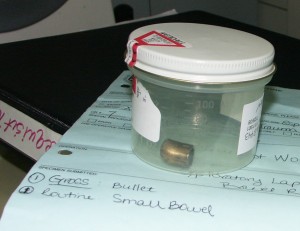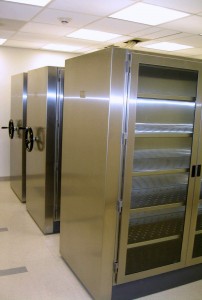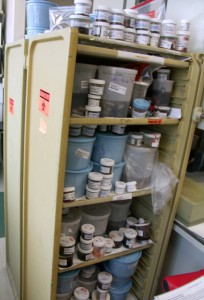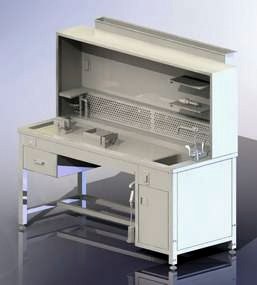This post was triggered by a visitor’s comment which expressed concern with inadequate ventilation discovered while monitoring formaldehyde level at the time of specimen disposal. In fact, this is a neglected area of safety in clinical anatomical pathology (surgical pathology laboratory and autopsy).
While preparing a reply to this comment, I realized that the issue of storage topic had been omitted from the website. This post tries to address this omission because storage is a significant part of grossing technology. And I would to emphasize again that grossing technology is much broader than specimen sampling, which is often how it is commonly understood.
This might sound paradoxical, but specimen storage begins with the receipt of the specimen, and thus even before accession. During the check of specimen’s belonging to surgical pathology can be saved space, efforts, and time. For example, what is this bullet doing in surgical pathology laboratory? Why a bullet has been sent to a surgical pathology laboratory? It definitely would not need a pathologist’s examination. Moreover, every contact with the specimen can compromise forensic examination. The bullet ought not to be in the laboratory in the first place.
Every institution has a list of surgical materials which should not be sent to surgical pathology laboratory. Otherwise, these irrelevant specimens, which are not qualified even for gross only examinations take up valuable storage space and are in the way of other specimens.
There are many technical details to be noted during accession. The surgical number of the specimen should be taken into account at the specimen-accession stage, as these can interfere with convenience and clarity during storage. For example, the surgical number should not be placed on the container indiscriminately. It should be written without interfering with information on the label. On large and middle size containers, the surgical number should be written just below the lid on the same vertical line with the label. It is an obvious detail, but an important one for real life practice in a surgical pathology laboratory, when the search for a specimen after grossing can often become a time consuming nuisance. It is important to place containers according to their size, so that their identification numbers are always visible. This is a small element of common sense that should reflect the work practice culture of the laboratory. A small element of common sense that might reflect a storage order and the laboratory work practice culture. When choosing appropriate equipment for storage, these details should be taken in consideration.
The type of storage space depends on the institution, as well as the kind of surgical pathology material being dealt with. As a rule, specimens are sent and kept in plastic containers closed with a lid (although they are sometimes incorrectly stored in containers such as zip-lock plastic bags.) This means that during storage evaporation of formaldehyde cannot occur unless there is a spill or the container’s outer surface is “contaminated” by formalin. The latter is quite possible. It is a part of appropriate laboratory culture to make sure that the container’s outer surface is formalin free, but this laboratory rule is often violated.
There are three main requirements to storage shelves:
Convenience is important for the productivity of the laboratory, helping to reduce any waste of time (sometimes significant) that might occur searching for a specimen that might be required for any number of reasons (e.g., pathologist’s observation, re-cut, distribution, etc.)
Security is important to prevent unauthorized intrusion that could compromise the specimen’s integrity. It also protects against displacement and misplacement. Ideally, the storage shelf should be locked, but this rarely occurs. There should at least be the possibility for this.
The so-called, legal cabinet is an obligatory fixture in every surgical pathology laboratory. The size differs depending on size of the laboratory and the profile of the institution and the surgical specimen materials, but its design should make possible to keep some documentation that is not a case in a regular specimen storage space. Again, a bullet or some other forensic material may not be in the proper place in the legal cabinet, but it can serve as a temporary storage space for misplaced forensic items until there is clarification. Some institution keep all “for gross only” specimens in the legal cabinet so as to prevent difficulties that would arise if the specimen were lost, but it is required by patients, lawyers, etc.. The specimen should be photographed (that is a correct thing to do anyway, keeping in mind difficulties in description of every “for gross only” specimen, especially surgical hardware) and placed with a copy of the requisition form. It is understandable that the size and shelving of the storage should be appropriate.
The legal cabinet obligatory should have possibilities to arrange specimens in strict order by year of accession because the storage of these specimens has indefinite time of maintaining. The storage of specimens placed without any order as at the picture below is unacceptable.
Safety of the storage site is a prime concern for the laboratory environment and personnel, given the dangers posed by the evaporation and spills of formaldehyde and other reagents. of the storage place for laboratory environment and personnel involved due to inevitable concern regarding formaldehyde and other reagents evaporation and spills. The safety the storage site is probably the most important issue that requires the management’s attention. This issue becomes especially significant during specimen disposal, when separation from formalin is necessary.
There are many wet specimen types of storage equipment. For example, Thalheimer Kuehlung manufactures Ventilated Specimen Storage Cabinets with a connection to an on-site exhaust air facility. MEDIS Medical Technology GmbH also manufactures storage cabinets for wet specimens. In my experience, the best in this field are TBJ. Inc’s storage cabinets. However, they are suitable for long- term storage; this is not the case in the surgical pathology laboratory given the frequent changes to the contents of the cabinet.
High Density Vented Mobile Storage. TBJ Inc.
In my opinion, the best storage equipment that meets all three criteria (convenience, security, and safety) is the moving shelves. Herman Miller Healthcare had manufactured them for a long time. The company calls them lockers. They have a garage-like tambour door and their depth allows the placement of containers from tallest to shortest, so that every surgical number is on display. The shelves can be adjusted to the height of the containers.
In contrast to stationary shelves attached to the walls, this storage can be easily cleaned using a hose, stream of water with detergent and disinfection reagents in a floor drainage room. It would be reasonable to have a sparer locker for cleaning and following a draying ”quarantine.”
In contrast to stationary shelves attached to the walls, this storage can be easily cleaned using a hose, stream of water with detergent and disinfection reagents in a floor drainage room. It would be reasonable to have a sparer locker for cleaning and following a draying ”quarantine.”
Spare moving shelves are a necessity in the surgical pathology laboratory because often specimens arrive in draws. The overcrowded locker below is begging for help.
It should be noted, a special cart-locker can be used as a legal cabinet. The table surface is convenient for documentation, photography, and temporarily taking items out to search for a required specimen.
The most important thing is that the lockers can be moved in the short distance to a table with an exhaust during disposal’s separation of formalin and the specimen. This is one of the elements of the procedure and requirements by the disposal companies. The main harm of formaldehyde exposure is not during storage, but rather during the disposal process when the specimen is taken out of the container. A combination of evaporation, spills, and splashes may occur at that time. See more details about wet specimens disposal in the post Wet Specimen Disposalin the Surgical Pathology Laboratory at the Grossing Technology & Beoynd blog.
Ideally , it would be combined with a Bone Grossing Table, as a temporary specimen disposal station.
TBJ.Inc. manufactures such a table.
The importance of proper storage in surgical pathology laboratories is underestimated. This post seeks to provide some information on what is required, and a personal approach to this part of the work.










